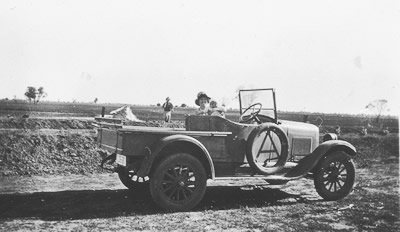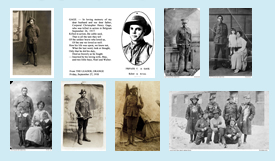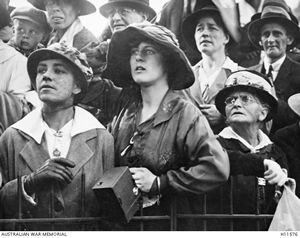History Stage 3
Overview

Woman and baby in truck on Soldier Settler block, Cowra, NSW, 1920
©Public domain (State Library of NSW)
Students investigate the contributions of Indigenous Australian servicemen in the First World War. They consider the impact of the First World War on the broader community, in particular, the changing role of women. Students also investigate schemes for returned soldiers including soldier settlements. Students investigate frontier wars in Australia.
Teaching and learning activities
1. Community—How did Aboriginal men and women contribute to the First World War?

Screenshot of gallery thumbnails
How did Australian society change throughout the twentieth century?
Read the text about Indigenous soldiers (under the Experiences>Perspectives tab) and view the image gallery.
Read the Australian War Memorial article about Indigenous Australian servicemen.
How did Aboriginal men and women contribute to the First World War? How did their experiences compare to other members of the AIF?
Additional information: Indigenous histories.
Undertake a search of images of Aboriginal servicemen using Trove and the Australian War Memorial websites. Develop a display or digital book with references and information about each one. An unknown number of Indigenous men enlisted in the First World War, researchers have now verified that over 1300 men enlisted.
Examine the webpage Army Indigenous Community. Read Stories of interest to gain a contemporary perspective on Indigenous men and women in the armed services. Provide some specific examples of their commitment to country.
2. Change—What was the impact of war on families and on women?

Women at the Anzac Buffet in Hyde Park, Sydney, wait to welcome home their loved ones
©Public domain (AWM H11576)
How did Australian society change throughout the twentieth century?
About the image on the right: A group of women in a crowd at the Anzac Buffet in Hyde Park, Sydney where relations waited to welcome home their loved ones, including some wounded, as the cars (not seen) drew up and deposited their loads of Returned Soldiers. The woman holding the Box Brownie camera is Miss Myra Harvey and beside her, the older woman with glasses, is Mrs Elizabeth McCallum. As men started returning from the front, the Anzac Buffet became the place where men were welcomed home.
Explore the impact of war on families and the broader community. List the impacts of the war on women.
If you were Miss Myra Harvey, the young woman holding the box brownie camera, role-play conversations with the soldier you are greeting about how life has changed for women since the war. Explore the challenges faced in families caused by the changing roles of women, such as the attitudes of the returned soldiers to their wives now working and bringing in an income.
Sources:
Women’s roles (under the Experiences>Perspectives tab).
Australian women in World War One (.pdf 4.23MB)
3. Caring—How did the Australian government care for returned soldiers?
How did Australian society change throughout the twentieth century?
There were over 9000 returned soldiers who became soldier settlers, many of whom opened up remote areas for farming.
Select a case study of a soldier on the site A Land Fit for Heroes? Use sources to investigate the conditions for soldier settlers and answer the question: Was this a suitable occupation for returned soldiers? Why or why not?
Note: Crown Land was often used for soldier settlements, at times this was land was home to Aboriginal peoples, inclusive of those from these communities who had enlisted and served in the First World War. These people were dispossessed by these settlement schemes. Aboriginal service men were not entitled to soldier settler land grants.
Sources:
Soldiers’ settlement photographs held at State Records
Bankstown Soldier Settlement Milperra
Hawkesbury Agricultural College (now the University of Western Sydney, Hawkesbury campus) trained many of the returned soldiers in specific farming and animal husbandry skills.
4. Challenge—Has Australia ever seen war on our own soil?
What were the significant events and who were the significant people that shaped Australian colonies?
Has Australia always been a peaceful country? Has Australia ever seen war on our own soil?
Use the posters from the Koori, Murri, Gurri and Palawa Storylines to identify examples of frontier wars.
What is a frontier war? Why did they occur? What happened? Why do many of these events remain unrecognised?
Search for some news articles about frontier wars as examples of the commentary about these events.
Read about how a community is providing a memorial that commemorates Aboriginal massacre.
Students write a short news piece about the challenge of recognising the frontier wars in Australia.
Sources:
Koori, Murri, Gurri and Palawa Storylines at Aboriginal timeline poster 1 (.pdf 600kB). Note, the entire set of posters can be accessed by changing the poster number from 1–8 on the pdf file name.
Western District memorial commemorates Aboriginal massacre (abc.net.au)
Learning concepts
These additional questions can be used for discussion or further investigations.
Challenge
Has Australia always been a peaceful country? Has Australia ever seen war on our own soil?
Change
What was the impact of the First World War on communities and roles within communities? How did the role of women change?
Caring
What government and voluntary schemes were established to help care for returned soldiers?
Community
How did Aboriginal men and women contribute to the First World War?
Commemoration
What is the significance of the Centenary of Anzac?
Syllabus links
HT3-2 describes and explains different experiences of people living in Australia over time
HT3-3 identifies change and continuity and describes the causes and effects of change on Australian society
HT3-4 describes and explains the struggles for rights and freedoms in Australia, including Aboriginal and Torres Strait Islander peoples
HT3-5 applies a variety of skills of historical inquiry and communication
Activities 1 and 2
Experiences of Australian democracy and citizenship, including the status and rights of Aboriginal people and/or Torres Strait Islanders, migrants, women and children (ACHHK114)
Students:
-
examine Australian human rights, past and present, affecting Aboriginal and/or Torres Strait Islander peoples, migrants, women and children
-
explain how Australian society has changed throughout the twentieth century for these groups
Activity 3
Stories of groups of people who migrated to Australia (including from ONE Asian country) and the reasons they migrated, such as World War II and Australian migration programs since the war (ACHHK115)
-
using a range of sources, research and describe the contribution of Aboriginal and Torres Strait Islander peoples and other groups to Australian society
Activity 4
The impact of a significant development or event on a colony, for example, frontier conflict, the gold rushes, the Eureka Stockade, internal exploration, the advent of rail, the expansion of farming, drought (ACHHK095)
Students:
-
identify events that have shaped Australia's identity and discuss why they were significant
-
use a range of sources to investigate ONE significant development or event and its impact on the chosen colony